Key Scottish Environment Statistics 2015
This publication aims to provide an easily accessible reference document which offers information on a wide range of environmental topics. It covers key datasets on the state of the environment in Scotland, with an emphasis on the trends over time wherever possible. The data are supplemented by text providing brief background information on environmental impacts and data source, a summary of the trend and brief information on the potential factors affecting the trend.
This document is part of a collection
Background
There are background drivers shared by many of the environmental measures which are reported in Key Scottish Environment Statistics. These generally correlate with the usage of resources, and the release of pollutants in the natural world. In many cases as these drivers increase, they lead to the worsening of a wide range of negative effects on the environment. In order to put the rest of the Environmental statistics into context, these drivers have to be accurately measured.
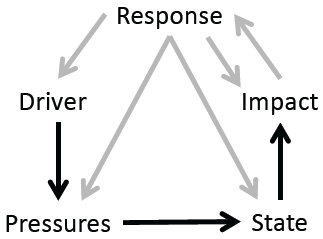
The overall framework of responding to environmental issues can be informed by the DPSIR model[1]. Under this, the pressures which directly affect the state of the environment are envisioned as being directly affected by drivers. These can be affected by responses from the government to try and improve the state of the environment, or mitigate the impact of the pressures. This chapter gives information on datasets which are often thought to be important drivers of environmental pressures.
For instance, the Gross Domestic Product (GDP) of a nation is fundamentally a measure of economic activity and economic activity will in general drive the use energy and other resources, leading to pressure on the state of the environment from carbon dioxide emission, waste and pollution, and ultimately impacting in terms of climate change. In order to ensure the long term sustainability of both the economy and the environment, Scotland needs to achieve economic growth without environmental degradation.
In order to maintain economic growth without causing additional environmental damage it is necessary to "decouple" the correlation between GDP and CO2 and other negative environmental effects. Many environmental policies are geared towards this goal, such as zero waste, circular economy, and renewable energies.
Targets and Aims
- 2017: Match the GDP growth rates of small EU countries
- 2017: Match average European (EU15) population growth rate
- 2020: 50% Electricity generated from Renewables
Population and Households: 1991-2037
Population/Households (thousands)[2]
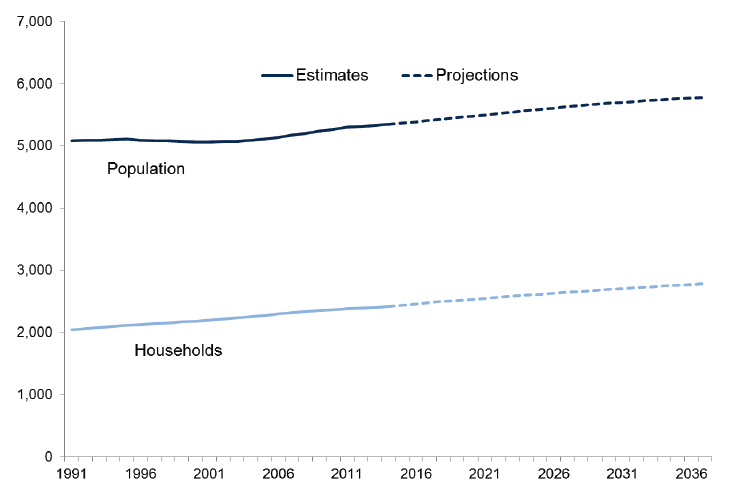
Why this measure is important
People and households are important consumers of energy and water, therefore the population and number of households will have an effect on the environment.
Background
Population estimates[3] are rebased with each census to ensure a consistent time series. Household estimates[4] for 2002 onwards are based on the number of occupied dwellings from council tax billing information.
Trend
The population of Scotland declined steadily through most of the 1980s, followed by small increases in the seven years up to 1995. The population subsequently decreased to a low of 5.06 million in 2000 before increasing to 5.35 million in 2014. The latest projections[5] indicate that the population will rise by 8.1% to 5.78 million in 2037. This trend is consistent with the overall UK population, which is also projected to increase but at a greater rate.
The number of households rose by 377,100 (18%) between 1991 and 2014. Projections[6] based on 2012 figures suggest that the number of households in Scotland will increase by 15% between 2014 and 2037, to 2.78 million.
Factors affecting trend
The growth in household numbers reflects changing household structures, with generally fewer people per household. Changes in population are due to changes in the numbers of births and deaths and migration. Since 2001, net migration has been positive with more people entering the country than leaving[7].
Source: National Records of Scotland | Metadata - Population / Households
Gross Domestic Product (GDP)[8]: 1998-2014R
Scottish GDP at basic prices (2012=100)
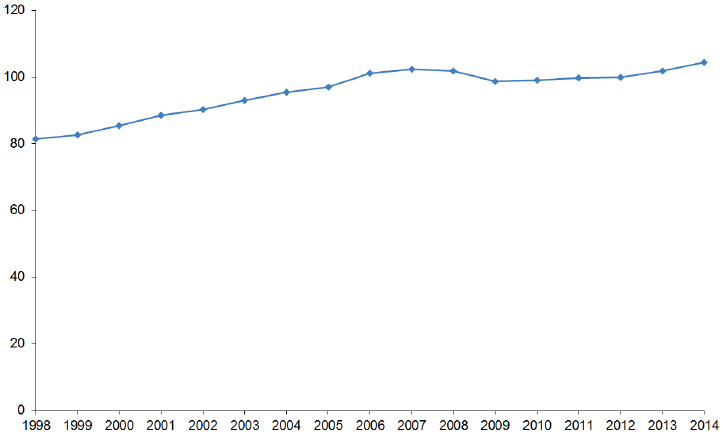
Why this measure is important
Scotland's Gross Domestic Product (GDP) is the main indicator of Scotland's economic performance. The GDP index is a short-term measure of output growth expressed in real terms. Traditionally, growth in GDP has been linked with environmental problems such as increased carbon dioxide emissions, waste and pollution.
Background
GDP estimates are adjusted for regular seasonal effects, and appropriately deflated to represent changes in the volume of economic activity rather than the value.
Trend
Over the 2014 calendar year, GDP in Scotland grew by 2.7%. This followed growth of 1.8% during 2013. Over the period 1998 to 2014, the Scottish GDP index increased from 81.5 to 104.5, representing an average annual growth rate of 1.6%.
Factors affecting trend
Scottish GDP can be affected by a number of factors, including overall economic conditions. This is seen most notably in the decrease in Scottish GDP of 3% between 2008 and 2009, following the deterioration in global economic conditions.
Source: Scottish Government | Metadata
Motor Traffic on All Roads: 1993-2014R
Million vehicle kilometres
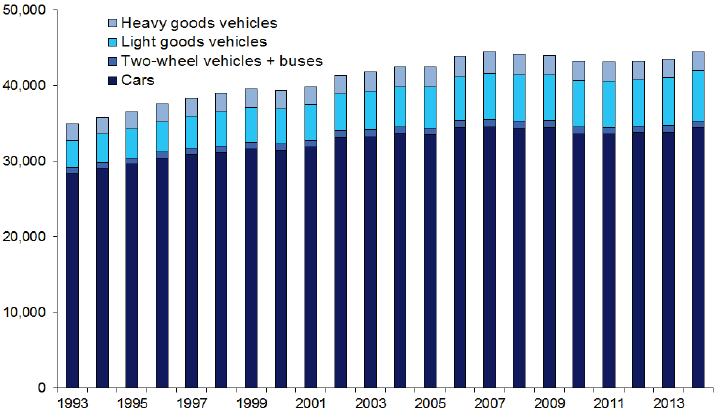
Why this measure is important
The pollutants emitted by road transport are a major contributor to poor air quality, which damages human and ecosystem health[9]. Fine particulate matter and nitrogen dioxide (NO2) are the pollutants of most concern, due primarily to their effects on human health. Transport emissions also contain carbon dioxide and other greenhouse gases (GHGs), which contribute to climate change.
Background
Data are provided by the Department for Transport as part of a UK wide survey.
Trend
Since 1993, the volume of motor traffic on major roads in Scotland increased by 30% to 29.4 billion vehicle kilometres in 2014. Compared with 1993, motor traffic on all roads was 27% higher in 2014, with increases of 46% for two-wheeled motor vehicles and 86% for light goods vehicles. Cars now account for 77% of motorised road traffic. The volume of motor traffic on all roads increased steadily from 1993 until 2007. During the period 2007-2011 there was a reduction in motorised road traffic; however, from 2012, levels have shown an upward turn reaching the highest level ever in 2014.
Factors affecting trend
There are a number of factors that may contribute to increases in motor vehicle traffic[10]. There were increases in the number of householders with access to at least one car for private use until around 2007 and this number has since remained fairly steady at about 70% of households in Scotland[11]. 2014 saw the most registrations of new vehicles in Scotland in a single year since 2007[12] and the total number of light goods vehicles registered is now at the highest level in at least the last 10 years.
Source: Department for Transport | Metadata
Electricity Generation by Source: 2000-2013R
Electricity generated (GigaWatt hours)[13],[14]
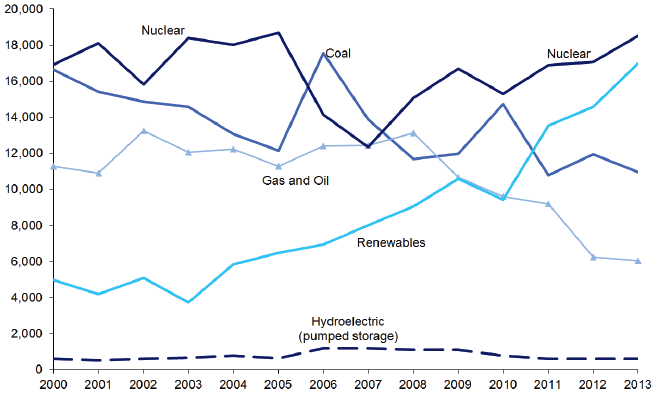
Why this measure is important
The combustion of fossil fuel, especially coal, is a major contributor to carbon dioxide emissions, which is one of the six greenhouse gases that Scotland is committed to reduce under the Climate Change (Scotland) Act 2009.[15]
Background
Data are obtained from the Department of Energy and Climate Change.
Trend
In 2013, Scotland generated 53,071 GWh of electricity, 5.2% more than in 2012. 16,967 GWh of this total (32%) was generated from renewable sources[16], which is an increase of 16.3% from 2012. This also equates to 44% of the gross consumption[17] of electricity in Scotland in 2013, compared with 39% in 2012. Fossil fuels accounted for 32% of Scotland's electricity generation in 2013, compared with 36% in 2012, while 35% of the electricity generated in 2013 was from nuclear power stations, compared with 34% in 2012.
Factors affecting trend
Fossil fuel generation in Scotland tends to vary over time and is influenced by a wide range of factors including fossil fuel prices (absolute and relative) and the prevalence of renewable and nuclear generation. The closure of Cockenzie Power Station in March 2013 also contributed to the reduction in electricity generated by fossil fuels. The total electricity generated by renewables is dependent on the capacity of renewable technologies and the weather.
Source: Department of Energy and Climate Change / Scottish Government | Metadata
Contact
Email: Kirsty Ciclitira
There is a problem
Thanks for your feedback